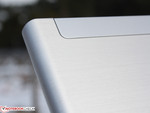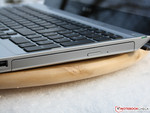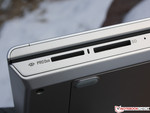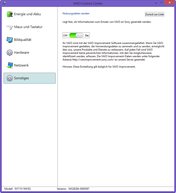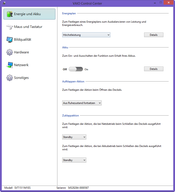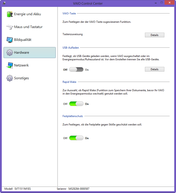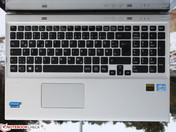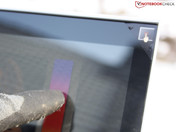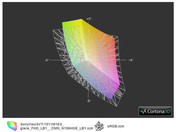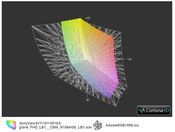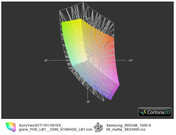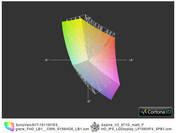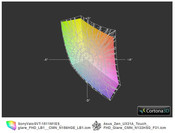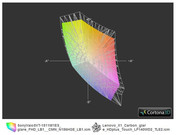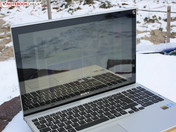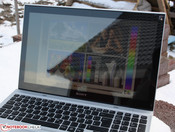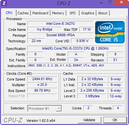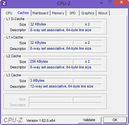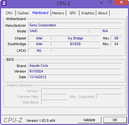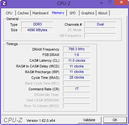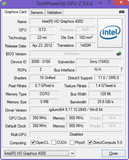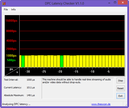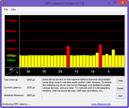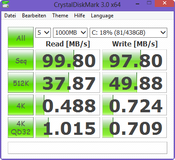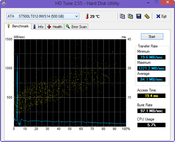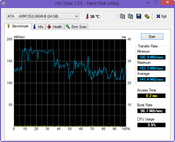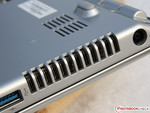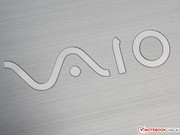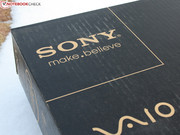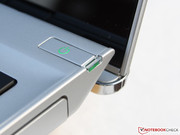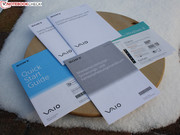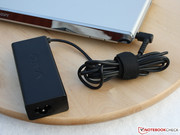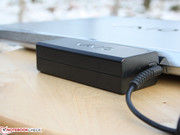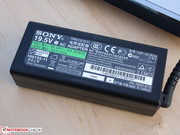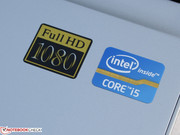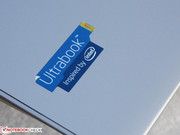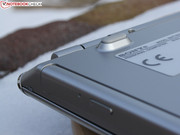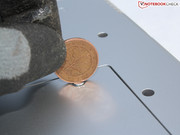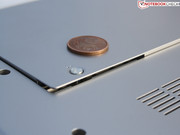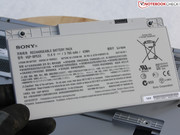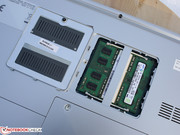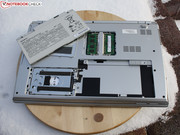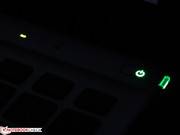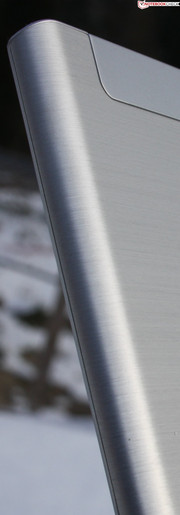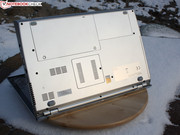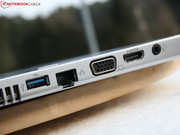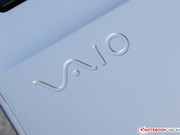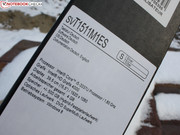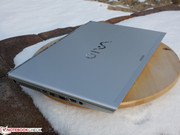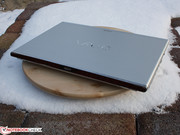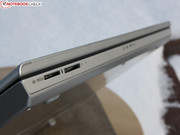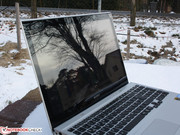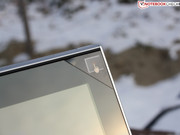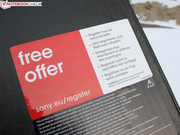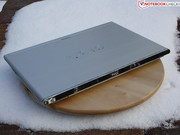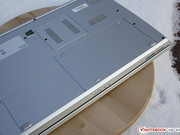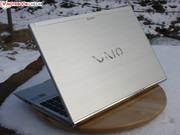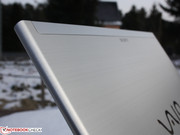Review Sony Vaio SV-T1511M1E/S Ultrabook

For the original German review, see here.
Sony does not hesitate and equips its first 15.6-inch ultrabook with a multi-touch TFT, which is not only adequately bright but also features a resolution of 1920x1080 pixels. This rouses curiosity seeing that the competition has touch models in this size available for prices starting at 1400 Euros (~$1821). HP's Spectre XT Touchsmart 15-4000eg (C1S43EA) featuring a Full HD touch IPS screen is a good example of the competition. Also, Asus' ZenBook UX51VZ (1550 Euros, ~$2016), Vaio SV-S1511X9E/B (1300 Euros, ~$1691), Apple's MacBook Pro 15 Retina 2.3 GHz Mid 2012 (1950 Euros, ~$2536) and Samsung's 900X4C-A04DE (1500 Euros, ~$1951) non-touch models are not exactly what we would call inexpensive laptops.
Due to its much lower price, we have to compare the Vaio SVT-1511M1E/S with competing laptops for below 1000 Euros (~$1300). But which ones should they be? Sony achieves the price advantage by omitting a dedicated graphics card (processor-integrated Intel HD Graphics 4000) and using a low-cost TN screen. The following contenders at least have an advantage in gaming performance since they all sport a more or less powerful graphics card. However, none of them feature a touchscreen and the base unit of all 15-inchers is at least 3 millimeters higher.
Full HD consumers for below 1000 Euros (~$1300)
- Acer Aspire V3-571G-53214G50Maii (IPS, GT 640M, i5-3210M, 650 Euros, ~$845)
- MSI GE60-i760M245FD (GTX 660M, i7-3630QM, 800 Euros, ~$1040)
- Lenovo IdeaPad Y580 (GTX 660M, i7-3610QM, Free DOS, 880 Euros, ~$1144)
- Medion Akoya P6635 (GT 630M, i5-3210M, 650 Euros, ~$845)
- Dell Inspiron 15R 2013 (HD 7670M, i5-3337U, 650 Euros, ~$845 - another version)
- ASUS N56VJ-S4045H (GT 635M, i5-3210M, 800 Euros, ~$1040 - another version)
- Dell Vostro 3560 (HD 7670M, i5-3210M, 650 Euros, ~$845)
Note: Notebookcheck often had the HD version of the laptops in the tests and the CPU, GPU as well as storage devices configuration could differ.
Case
We repeatedly praised the build of the Vaio T13 model in the previous three tests (pre-series, series, touch version). The surfaces of (partly brushed) aluminum, low overall height and rigid chassis let the hearts of laptop friends beat faster.
Sony adopts the looks, material and feel but the user has to accept cutbacks in stability. The biggest factor is the somewhat less rigid lid. The stiffness is still considerably better than seen in many contenders.
The base is five millimeters higher than that of the T13 (T15: 23 mm without feet, 28 mm with feet at the rear), but it has to manage with an optical drive when opened. The keys yield a bit over the drive and the base plate can be dented evidently at the edge. Potential buyers cannot expect the rigidness of an aluminum unibody, which the T range never had anyway. The battery is removable, but that does not affect the 15-incher's stiffness. In return, the feel-quality is very high standard, as was the case in the T11 and T13.
The display lid features an edge-to-edge design. The surface-covering pane is adequately pressure resistant, though not as solid as in most tablets. Unlike the non-touch version of the T13 where the testers criticized the pliable, thin lid, the edge-to-edge design supports the lid's stiffness.
The hinges are pulled tighter than in the non-touch T13 and both hands are now needed to open the ultrabook because the base would lift otherwise. This is intentional because the TFT shouldn't be pushed back too easily when tapping on the screen with a finger. Regrettably, the hinge allows the lid to rock, which quickly gets annoying when tapping hectically.
Connectivity
Sony relies on standards in connectivity. VGA and HDMI are available like in all Full HD contenders listed above, except for the Inspiron 15R (HDMI only). The Vaio does not omit an Ethernet port but it does not have a Kensington lock. The front features two card readers: Sony's standard Memory Stick (Pro/Duo) and a reader for SD cards.
Among the equally priced contenders, the Asus N56VZ offers a total of four USB ports alongside a dedicated subwoofer port. The other devices at most sport more USB 3.0 ports, but feature the same interfaces otherwise.
Buyers who are willing to spend more do not necessarily get more. The Spectre XT Touchsmart 15-4000eg includes a mini DisplayPort/Thunderbolt port (no VGA) just like Apple's MacBook Pro 15 Retina. Samsung's 900X4C-A04DE (no RJ45, micro HDMI) and Asus' ZenBook UX51VZ do not have VGA, but mini VGA.
Communication
Sony installs today's standard communication interfaces, i.e. Gigabit Ethernet and Wi-Fi IEEE 802.11 b/g/n, which only transmits in 2.4 GHz and not the usually wider 5 GHz band. Sony relies on the latest short-range transmission standard with Bluetooth 4.0 HS.
The Wi-Fi modules reception satisfied us even over longer distances. The reception is excellent at a distance of both three and ten meters (upper floor). It dropped to two bars outside the building (15 m) and only one is displayed at 40 meters. The Fritz!Box 7270 router's transmission rate was 50%.
Maintenance
Sony states an upgradability to 8 GB for the 15-incher. The two DIMM slots (1 x 4 GB occupied) are below an aluminum cover on the bottom. Intel's chipset, or more precisely the processor with the dual-channel DDR3 memory controller, should actually support up to 16 GB (DDR3-1333 MHz). However, we did not try this. The second maintenance cover only conceals the 2.5-inch HDD slot. It is not possible to access the Wi-Fi module, CMOS battery or cooling system for cleaning purposes.
Accessories
The accessories stop with a quick start guide, recovery notes and a few Windows 8 tips besides the power supply unit. The former, customary polishing cloth is no longer included.
Warranty
Sony includes a 12 month bring-in service on the Vaio SVT-1511M1E/S. This standard warranty can be upgraded free of charge when the ultrabook is purchased via one of Sony's online partners and the device is registered. A 24 month warranty is included when the device is bought in the Vaio online store. A 1-year warranty upgrade costs 130 Euros (~$169) and includes pick-up and repair service on 5 business days and telephone support. A four year all-round warranty costs a steep 350 Euros (~$455) but includes a product exchange service in the first 3 months (Germany only) and a 4 year accidental damage protection.
Webcam
The webcam has a resolution of 1280x800 pixels. The pictures exhibit a visible noise and poor focus even in daylight. The colors have a reddish cast. Thus, the pictures of the "HD Web Camera powered by Exmor for PC" are virtually useless. Asus' VivoTab TF810C shoots much sharper pictures even with its 2 MP rear-facing camera.
Input Devices
Keyboard
Sony installs a chiclet keyboard including a number pad. The main keys feature a pleasant size of 15 x 15 mm. The gap between the keys is 4 mm. The key drop is short, which leads to poor typing feedback alongside the soft and undefined pressure point. Although the key bed does not yield under normal typing pressure, the stroke is soft but also quiet.
The generous layout featuring a wide shift key, big enter key, clearly positioned CRTL and DEL key offer a lot of room even for larger hands. The somewhat reduced arrow keys are clearly separated from the others and can be found without looking. Our fingers quickly accustomed to the keys' even surface and the touch-typing accuracy was high. The backlit keyboard facilitates typing in the darkness or dim light. It does not feature levels and can only be turned on and off. The Vaio Control Center always has to be opened first to disable it permanently. There is no FN key for this purpose.
As usual, special keys are located above the keyboard. The "Vaio" key opens the "Vaio Control Center" and the "Web" key opens the default browser. The "Assist" key opens Vaio Care, which provides troubleshooting tools. For example, creating a recovery DVD begins here.
Touchpad
Sony treats the SVT-1511M1E/S to a 5.6 x 9.9 cm clickpad from Synaptics (v 8.1). A clickpad is a touchpad without dedicated mouse keys. The entire pad is a big clickable button. Either the left or right mouse key is prompted depending on the finger's position at the lower edge. The clickpad has a fine, quiet and yet agreeable pressure point. It is clearly palpable and matches perfectly to the pad's medium drop.
The surface is matte and, like the rest of the wrist rest, sleek but not slippery. We often wiped beside the clickpad because the difference between both surfaces is hardly detected. Like the touchscreen, the pad supports multi-touch and features such as pinch-to-zoom on pictures.
Display
The 1920x1080 pixel, WUXGA, FHD multi-touchscreen from CMN (read out as N156HGE LB1) is not the driving force behind the Vaio T15. Sony opted for a TN screen, like most contenders from the below 1000 Euros (~$1300) price range. Twisted Nematic is the traditional and simplest method of imaging a liquid crystal screen (TFT). The biggest drawback in contrast to IPS models is the much weaker viewing angle stability, as we also determined further below.
As described above, the screen features a resistive multi-touchscreen that can be used with a finger but not a stylus. Consequently, it cannot be used when wearing a glove. The contrast of 516:1 is acceptable for an office or multimedia laptop. The brightness is sufficiently distributed. We did not notice any bright spots or clouding on a black background.
| |||||||||||||||||||||||||
Brightness Distribution: 83 %
Center on Battery: 230 cd/m²
Contrast: 516:1 (Black: 0.595 cd/m²)
55.3% AdobeRGB 1998 (Argyll 3D)
76.8% sRGB (Argyll 3D)
53.5% Display P3 (Argyll 3D)
We compared the screen's color space with sRGB, AdobeRGB (target color gamut) and other premium screens (Full HD & HD+). Only Lenovo's X1 Carbon sports a TN screen. The others are IPS models. sRGB and AdobeRGB are clearly failed. The contenders don't do a much better job although their spectrum covers a larger range. Color gamut is particularly important for professional image editors.
The following three screenshots depict the color analysis using i1 Pro 2 color spectrometer and CalMAN 5 software. A clear weakness in gray reproduction is seen when measured in the default color profile (before calibration). Particularly the medium gray hues show a DeltaE(2000) of over 10 (average 13). Striking: the white point is almost exactly at the optimum of 6500 K with 6823 K (see color saturation). Nevertheless, the color accuracy is strongly affected. Cyan and magenta are far from the target coordinates, which is acknowledged with a DeltaE 2000 of over 10 (magenta) and over 5 (cyan). The frequently observed bluish cast in TN screens is again seen here.
The reflective surface disqualifies the touch Vaio for use on the terrace. The glare-type screen reflects its surrounding to such an extent even in cloudy conditions (despite 230 cd/m² on battery) that pleasant working is not possible. Considering this impression, it is inconceivable that the brightness is throttled to 230 cd/m² (center) on battery power. However, 283 cd/m² would not have improved this much either.
We experienced extreme difficulties taking pictures with the webcam because a lateral view on the screen is virtually impossible due to the narrow viewing angles. Our standardized measurement in the darkroom confirmed this. The TN screen model (Twisted Nematic) only allows horizontal views up to a maximum of 45 degrees on the Vaio (lateral view, see screenshot). Extreme inverting begins beyond that. The slightest vertical deviations from 15 degrees already cause ghosting. The only model among the below 1000 Euros (~$1300) contenders that currently features first-rate viewing angles is the Aspire V3-571G with IPS and AR-coating (price: 650 - 800 Euros, ~$845 - $1040, depending on configuration). The high-priced competition sports superior equipment (IPS or PLS screens).
Performance
The Vaio SVT-1511M1E/S is configured with Intel's Core i5-3337U (2 x 1.80 GHz). This is the first time we have this CPU in our tests. It is an Ivy Bridge scion and the new, bigger brother of the Core i5-3317U (2 x 1.7 GHz). Sony currently does not offer any other retail versions. However, it is possible to manually configure a Core i3 and i7 in Sony's Vaio store. The same goes for the hard drive. Our test device sports a 500 GB HDD in addition to a 24 GB SSD cache. It is possible to opt for a T15 with a 128, 256 or 512 GB SSD in Sony's online store.
Processor
Our CPU can be clocked up to 2.7 GHz (3317U: 2.6 GHz) via Turbo Boost 2.0. This leads to an increase in the processor's performance compared with the i3 (no Turbo). However, this always requires a sufficiently sized cooling system, which many thin ultrabooks did not have in the past. We examined whether the T15's Turbo works properly using the Cinebench R11.5 multi & single core benchmark. It includes the integrated Intel HD Graphics 4000, which also features Turbo (OpenGL test).
The 3337U in our T15 achieved identical scores as a 3317U in the 900X4C-A04DE, Inspiron 15R-5521 and Spectre XT Touchsmart 15-4000eg (multi 64 bit). All other contenders in the chart are based on Core i5 and i7 standard voltage processors (35 rather than 17 watts), which enables a performance plus of 30 to 60%. The clock rate during the tests was always 2.5 GHz.
The consumer competition of course fares better in the OpenGL test because they all sport a dedicated graphics card. The best scores were reaped in by a GeForce GTX 660M (IdeaPad Y580) or GT 650M (Asus N56VZ). An equivalent HD 4000 in the 900X4C-A04DE and Spectre XT Touchsmart 15-4000eg scored a bit worse due to single-channel memory (HP) or lower clock rate (Vaio T15: OpenGL 950 MHz).
Thus, the cooling in the small chassis manages to cool the processor sufficiently. Throttling was not observed. The performance remains identical on battery power; all three CB R11.5 tests finished with equally good scores.
System Performance
The computing power is low compared with the standard processors. How does this affect the application performance? We used PCMark 7 (2011) to ascertain this and were surprised. Our T15 went through the roof and the expensive Asus UX51VZ and Apple MacBook Pro Retina 15 high-end machines only have a lead of almost 60% (computing performance approximately + 135%). Quad-core systems, such as MSI's GE 60 or Asus' N56VZ, lag behind by about 30%. Where does this unusual power come from?
| PCMark 7 Score | 3492 points | |
Help | ||
Storage Devices
HDTune read at an average of 84 MB/s, which is a common rate for a 5400 rpm hard drive and is not the reason for the high PCMark 7 score. CrystalDiskMark recorded 100 MB/s, so that's not it either. CDM's 4K test didn't exactly rock either: 0.488 was displayed, but SSDs manage 6 to 20 MB/s so 12 to 40 times as much.
It is the 24 GB SSD cache that is responsible for the high HDD score in PCMark 7. HDD-only systems are roughly 30% slower in this measurement. Genuine SSD systems add 90 to 100% on top. Regrettably, only HDTune could directly address and measure the SSD. AS-SSD and CrystalDiskMark completely ignored the cache's presence. The user will not notice it either because there is no visible Windows drive for these 24 GB, as intended for a read/write cache. The storage capacity is used for frequently read data, which speeds up opening programs, booting the system and apparently even PCMark 7. Windows rates the primary hard drive with 5.9. This is not a particularly high score and is in line with HDTune and CrystalDiskMark.
Graphics Card
The processor-integrated HD Graphics 4000 supports DirectX 11. Video converting programs, such as Cyberlink Power Director, benefit from Intel's Quick Sync. The GPU also features a Turbo (350 - 1050 MHz). However, Cinebench OpenGL test above showed that the clock settles to 950 MHz. The clock remains stable at 350 MHz on battery power, providing that it is set in Intel's settings (energy-saving). The GPU's full power is available in performance mode, even on battery power.
3DMark 2006 is quite high for a HD 4000, which is likely due to the processor Turbo support in the case of this benchmark. The majority of i5 ultrabooks achieve approximately 4500 points. The less CPU dependent 3DMark 11 shows the drawback of a single RAM module. A dual-channel memory, i.e. two RAM modules, could boost the score to approximately 650 and slightly increase the following gaming performance.
| 3DMark 06 Standard Score | 4892 points | |
| 3DMark 11 Performance | 587 points | |
Help | ||
Gaming Performance
Games are only an insignificant topic for the HD 4000. That is not due to the lack of a dual-channel memory, but generally because of its classification as an integrated, entry-level GPU. The following chart shows that very undemanding titles like Diablo III run smoothly at most. Even older games, such as Starcraft 2 or Anno 2070, have to be satisfied with minimum details. Of course, the 1024x768 pixels do not come close to the possibilities of a Full HD screen.
The chart shows the placement of particularly slim, high-priced contenders in gaming performance. The UX51VZ and MacBook Pro 15 come with a GT 650M, so both the Spectre XT with a HD 4000 as well as our test device do not stand a chance. Users who want to do some serious gaming on a Full HD screen should look at the consumer competition for less than 1000 Euros (~$1300). We listed them in the comparison bar chart above. Acer's Aspire V3-571G-53214G50Maii featuring an IPS screen and GT 640M is currently a real performance bargain in both aspects (from 650 Euros, ~$845, GT 730M version more expensive).
| Sony Vaio SV-T1511M1E/S HD Graphics 4000, 3337U, Seagate Momentus Thin ST500LT012-9WS142 + 24 GB SanDisk U100 SSD Cache | HP Spectre XT TouchSmart 15-4000eg HD Graphics 4000, 3317U, Samsung SSD PM830 256 GByte mSATA | Asus UX51VZ GeForce GT 650M, 3612QM, 2x ADATA XM11 256 GByte | Apple MacBook Pro Retina 15 inch 2012-06 GeForce GT 650M, 3615QM, Apple SSD SM256E (Samsung) | |
|---|---|---|---|---|
| StarCraft 2 | ||||
| 1360x768 medium (fps) | 28 | 79 182% | ||
| Anno 2070 | ||||
| 1366x768 Medium Preset AA:on (fps) | 21 | 17.9 -15% | 61.2 191% | |
| Diablo III | ||||
| 1366x768 High AA:on (fps) | 26 | 95.6 268% | 106.4 309% | |
| Total Average (Program / Settings) | -15% /
-15% | 230% /
230% | 246% /
246% |
| low | med. | high | ultra | |
|---|---|---|---|---|
| StarCraft 2 (2010) | 151 | 28 | 18 | |
| Anno 2070 (2011) | 42 | 21 | 13 | 7 |
| Diablo III (2012) | 51 | 31 | 26 | 17 |
Emissions
System Noise
The fan was sometimes off when idling. Then only the quite whir of 30.5 dB(A) from the HDD was heard. We only recorded 31 dB(A) when the read/write heads were working. A temporary increase to 36 dB(A) was noticed for a moment after a load period, such as video converting or gaming. This rarely occurred in office use where the computer mostly idles.
Medium load, such as in 3DMark 06, caused the fan to work louder with an ascertained 42 dB(A). That is also almost the maximum noise of 44 dB(A). We provoked this using the stress test via Prime95 (CPU, multi-core test) and Furmark (GPU). The fan spun consistently in both cases.
Noise level
| Idle |
| 30.5 / 30.6 / 36 dB(A) |
| HDD |
| 31.2 dB(A) |
| DVD |
| 35.8 / dB(A) |
| Load |
| 42.2 / 43.7 dB(A) |
 | ||
30 dB silent 40 dB(A) audible 50 dB(A) loud |
||
min: | ||
Temperature
The T15 remained relatively cool in idle and the surface temperatures only increased selectively up to 42 °C during high, constant load. The average temperature only increased by 3 °C on the top during the stress test, which is due to the always cool surfaces that are blue in our chart. Using the ultrabook on the lap is always possible.
CPU throttling is not an issue for the Vaio T15. The CPU clock during the stress test (multi-core load) remained constant at 2.0 GHz. That is less than the theoretical Turbo of 2.6 GHz but it clocks at (almost) full power with 2.5 GHz in CB R11.5 (see performance). The full Turbo power is not a matter of course in slim laptops. The recently reviewed HP Spectre XT Touchsmart 15 clocks at approximately the same rate (~2.0 GHz), the ZenBook UX51VZ (standard Core i7) periodically throttles all four cores to 1.2 GHz. Among all listed consumer laptops, only Lenovo's IdeaPad Y580 suffered when Turbo was disabled in the stress test (remained at default clock).
(±) The maximum temperature on the upper side is 42.4 °C / 108 F, compared to the average of 34.3 °C / 94 F, ranging from 21.2 to 62.5 °C for the class Office.
(+) The bottom heats up to a maximum of 36.3 °C / 97 F, compared to the average of 36.8 °C / 98 F
(+) In idle usage, the average temperature for the upper side is 29.9 °C / 86 F, compared to the device average of 29.5 °C / 85 F.
(+) The palmrests and touchpad are cooler than skin temperature with a maximum of 28 °C / 82.4 F and are therefore cool to the touch.
(±) The average temperature of the palmrest area of similar devices was 27.6 °C / 81.7 F (-0.4 °C / -0.7 F).
Speakers
The two speakers are located exactly above the keyboard. The volume is not particularly loud but does not scratch at maximum volume. Like in many laptops, it does not feature a balanced sound. The focus is very obviously placed on the mids. Low ranges and trebles are highly neglected. Lenovo's U510 recently proved that even slim laptops can offer decent sound. The manufacturer uses a part of the chassis as a sound box and the speaker openings are virtually invisible.
Energy Management
Power Consumption
An idle runtime of 5:34 hours using minimum brightness and energy saving mode does not point to particularly long runtimes. The 15.6-inch ultrabook only has a 43 Wh battery. The fairly high power consumption of minimum 9 watts and maximum 15 watts in idle would also only total not quite three to just below five hours.
A look at the equally sized competition with and without a low voltage CPU shows a very similar idle power consumption. However, that is due to either a dedicated GPU or standard voltage CPU with much higher load consumption (min idle/max idle/stress test): HP Spectre XT Touchsmart 15 (8-17 watts; 38 load max.), ZenBook UX51VZ (0-13 watts; 90 load max.), Sony Vaio SV-S1511X9E/B (7-14 watts, 73 load max.). Among the inexpensive devices, Acer's Aspire V3-571G-53214G50Maii (8-17 watts; 81 load max.) consumes slightly more power in maximum idle, for example.
The stress test (Prime95, Furmark) provokes the maximum power consumption. We measured 41.5 watts here. The 65 watt power supply unit is designed sufficiently for this. Recharging the battery took 223 minutes (3:43 hours) during load.
| Off / Standby | |
| Idle | |
| Load |
|
Key:
min: | |
Battery Runtime
The 15-incher does not have to shy from comparison with the competition, at least not when we look at competitors for less than 1000 Euros (~$1300). The T15 finished the Wi-Fi test after 232 minutes (3:52 hours). For this, a script opens a different website every 40 seconds, some with video playback. The brightness is dimmed to 130 cd/m² (2 levels) which comes closest to our 150 cd/m² standard. Dell's Inspiron 15R, also with a low voltage CPU, lasts much longer with 430 minutes and a 65 Wh battery.
- Acer Aspire V3-571G-53214G50Maii (169 min; 48 Wh)
- MSI GE60-i760M245FD (175 min; 49 Wh)
- Lenovo IdeaPad Y580 (405 min; 72 Wh)
- Dell Inspiron 15R 2013 (430 min; 65 Wh)
- ASUS N56VJ-S4045H (194 min; 56 Wh)
- Dell Vostro 3560 (170 min; 48 Wh)
It looks better for the more expensive contenders. Only HP's Spectre XT Touchsmart 15-4000eg (214, 48 Wh) is surpassed. Asus' ZenBook UX51VZ (317, 70 Wh), Vaio SV-S1511X9E/B (274, 49 Wh), Apple's MacBook Pro 15 Retina 2.3 GHz Mid 2012 (364, 95 Wh) and Samsung's 900X4C-A04DE (580, 62 Wh) managed up to twice the runtimes but with partly twice the battery capacity. However, we only consider the comparison with devices from the less expensive contender list as fair. The just named laptops cost 1.5 to 2 times as much as our Vaio T15 model (900 Euros, ~$1171).
DVD movie playback is shorter (155 minutes) than the Wi-Fi runtime because we use the maximum average brightness of 230 cd/m² but disabled Wi-Fi for this test. The idle runtime of 334 minutes is also more theoretical because it is not practical to scroll through a TXT file in minimum brightness.
Verdict
The Vaio SVT-1511M1E/S is a stylish 15-inch ultrabook that makes a good to very good impression in terms of build, feel, quality and ergonomics. The user will like to place the slim device on the desk and the backlit keys guide the fingers. Unfortunately, the keys' poor feedback and the very good-to-use clickpad is a contrasting pair.
The touch-control of the glare-type screen works as expected. However, it did not convince us due to the operating hand's inconvenient positioning in front of the opened TFT. Are we supposed to lie on the couch and read an e-book? Or sweep through the internet? Somehow, touch on a tablet is more fun after all.
We would have hoped for more satisfaction from the Full HD screen. Contrast and brightness are acceptable, but the narrow viewing angles do not seem appropriate for this high-quality ultrabook. We already criticized the weak TN screen in the T11 and T13 (touch and non-touch) models.
The performance of Intel's Core i5-3337U was never slowed down by thermal throttling and that certainly earns a special mention in a slim laptop. The system performance is on a high standard although the combination of a 500 GB HDD + 24 GB SSD cannot hold a candle to swift SSD systems (SSD optional in Sony's online store).
Sony opted against a strong, dedicated graphics card while developing the Vaio SVT-1511M1E/S and thus opposes the trend. All contenders of the below EUR 1000 price range feature more or less powerful, dedicated graphics cards. This is however not generally true because the high-priced competition partly also relies on the processor-integrated Intel HD Graphics 4000: HP Spectre XT Touchsmart 15-4000eg & Samsung 900X4C-A04DE. Asus' ZenBook UX51VZ steps out of line seeing that it turns into a gaming laptop with its GeForce GT 650M, like Apple's MacBook Pro 15 Retina 2.3 GHz Mid 2012. The Vaio SV-S1511X9E/B features a slightly weaker GeForce GT 640M LE, but it is aimed at business customers.
There is not really an alternative for below 1000 Euros (~$1300). The 15.6-inch Acer Aspire V3-571G (GT 640M, i5-3210M, 650 Euros, ~$845) sports an extremely good, matte IPS screen for less money. However, its build is hopelessly inferior to that of the Vaio. Users looking for a competitive or even better build and who do not want to be stunned by the screen will have to save longer and look at the ZenBook UX51VZ, Spectre XT Touchsmart 15 or Sony VAIO SV-S15. We explicitly did not count these devices to the contenders because of their much higher price.




